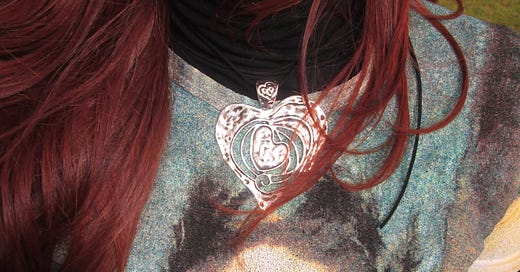The Maximalist "Weird Girl", Hardship and Newness
Inspired by the cartoonish, she is hyper-individualised mass production with taste so bad it becomes exceptional. But are they a mark of change, or the product of a culture obsessed with newness?
The result of a process of gestation initiated during the pandemic, the aesthetic current of “weird girl” maximalism that erupted in 2022 remains with us a year later – an arguably significant feat in a milieu made up of ephemeral pseudo-subcultural flows.
You have seen her before – indulgent, fun, colourful and absurdist. The “weird girl” (a term that I use irrespective of gender) would appear to have taken the Jungian pursuit of healing her inner child a tad too literally. They’d unironically wear the GCDS x SpongeBob crochet bikini, state that the MSCHF Big Red Boots are “what fashion should be about”, and sport a knit balaclava as a “Depop-ified … virtue signal” that they aren’t “like the rest of the fashion crowd”. The weird girl is a cyber girl, her style always technologically mediated and preferably immortalized on 2000s digicams bought off eBay. Weird girls layer, accessorize and customize against “good taste” and perhaps also meteorological awareness – who says bikinis and knit balaclavas aren´t meant to be worn together? Irony with a hint of nostalgia permeates their hyper-individualist style, think over-plucked eyebrows, tooth gems and thin rectangle glasses.
As is well known by now, this brand of maximalism is practiced by high and street fashion alike. Famous high-profile examples of “weird maximalism” include Marc Jacobs´ brand Heaven and the style of media personalities like Doja Cat, Bella Hadid, Gabriella Karefa-Johnson and Iris Law, amongst others.
The sociocultural context leading to this particular moment is interesting and worthy of analysis. Indeed, the re-emergence of maximalist style is not only attributed to the swinging pendulum of fashion (an endless cycle in which minimalism rejects maximalism and vice versa), but has also been historically linked to periods of economic hardship and distress. While early 00s baroque aesthetics may be seen as rejecting 90s quiet luxury, Harajuku maximalism in 1996 Tokyo was a direct response to Japan´s Lost Decade, a period of economic slowdown characterised by low employment rates that pushed some Japanese youths to value their “individual identity over corporate family identities”.
Significantly, present day “weird maximalism” takes obvious inspiration from Japan´s Harajuku maximalism for perhaps more than simply aesthetic reasons. It is important to consider that the ending of 2010s minimalism was in many ways accelerated by Covid, particularly in its interior décor iterations but also in the realm of fashion – remember the popularity of fast-fashion brands such as O-Mighty or Shop Cider, and the gentrification of second-hand shopping. The results were a wave of generational dysmorphia sparked by the all too accurate costume design of White Lotus´ Portia and the popularization of abstract wall murals, velvet sofas and colorful twisty candles. Much like the product description of the Big Red Boot announces; “cartoonishness is an abstraction that frees us from the constraints of reality”.
Undoubtedly, “weird maximalism” offers interesting opportunities for subversion. As was the case with most Harajuku fashion, the movement follows a ground-up logic by relying on the creative tendencies of urban youths while rejecting the constraints of “categorical trends” in favour of “unbounded maximalism”. In Deleuzian terms, it is a schizophrenic style that opposes neuroticism´s incessant search for security and stability. As if the illusion of a painless existence had been shattered by the pandemic and its ongoing economic consequences, this fashion of “madness” is a “break from power in the form of a disconnection”. Yet, ironically, it is precisely because of this disconnection that “weird maximalism” has the potential to be an outwardly oriented aesthetic, or a style that invites engagement with one´s environment and goes against neoliberalism´s ethos of “blending in and looking down”.
However, “weird maximalism” isn’t impervious to fetishisation and remains vulnerable to axiomatic re-connections with neoliberal logics. As written by Braidotti, capitalism often traps us in cultural dynamics that are obsessed with newness, “multiplying and distributing differences for the sake of profit”, but ultimately rejecting in-depth change. She describes this as a manic-depressive cycle “packaged in modes of social representation which alternate between the euphoric and the apocalyptic”. Like many of its aesthetic predecessors, “weird maximalism” is inevitably absorbed by euphoric neoliberal fetishisations of marginal creativity, i.e. the fashion industry´s historical appropriation and commodification of the creations of those at the margins. Certainly, the influence of Harajuku styles and Black-American 2000s maximalism on our present cultural moment is often understated.
Moreover, there exists a sharp contrast between the absurdist, childish and free-spirited tone of “weird girl” fashion and the rigidity and discipline that its highest exponents often exhibit. Yes, the mainstream “weird girl” is silly, eclectic and over-the-top, but her biggest accessory is a history of cosmetic modifications, invasive treatments and a rigid gym routine1. See, for example Brazilian It girl @livia, or Bella Hadid and Iris Law´s personable Tiktok accounts.
Whether she inscribes change or simply reinforces a fixation with newness, the “weird maximalist girl” is now an emblematic figure of early 2020´s fashion. Finding inspiration in the fantastic, the cartoonish and the absurd, and living in a post-Covid world where the boundaries of the imaginable are enlarged daily by AI technologies, climate emergencies and identity-politics, she is hyper-individualised mass production with a fashion taste so bad it becomes exceptional.
This is a point personally suggested by Zayna Mansuri





